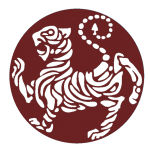Central to dojo etiquette is the rei or bow. Some societies have religious objections to the bow, however the bow in karate has no religious significance – it is merely the Eastern equivalent of shaking hands. The bow is a mark of respect not of worship.
Students are expected to bow on entering and leaving the dojo (training hall), this expresses your gratitude for being allowed to train therein. Students will also bow on command to the sensei or instructor who will return the bow. This signifies mutual respect between teacher and student – the teacher will do his best to pass on his karate knowledge and the student undertakes to learn this knowledge to the best of his/her ability. The final bow between instructor and students made at the end of the training session is a mark of gratitude to both parties for being able to train and learn together. Students will also bow to their training partners and this bow must be taken very seriously. This bow is a mutual means of saying “I willingly give you my body on which to practise your technique on the understanding that you will not abuse this privilege” and at the same time thanking your partner for the use of his body and promising not to abuse it.
If you arrive late for training you should kneel down (called ‘sitting in seiza’) by the entrance and wait to be acknowledged by the instructor. On acknowledgement you should perform a seated bow and join the class.
Depending on the formality of the class, you may also be asked to bow to Shomen. Shomen means ‘front of head’ ie face. The dojo’s face is the high point of the dojo, a place in Japan where a shrine may be installed. Often this is just a blank wall in this country but this bow has philosophical connotations with your own ‘face’. You are acknowledging your own gods, your personal goodness of character, your well being etc.
The bows can be interpreted in another way. We do two formal bows at the start of training and three at the end. The initial two bows, one to Shomen and one to Sensei (called by the senior student) pay respect to past instructors and the present one. The three bows at the end of training pay respect to past instructors, the present instructor and future instructors ie you, the current students who have now been taught something and will hopefully continue the tradition and pass on your knowledge.
You must also show respect for the sensei and what he is teaching you. So there must be no unnecessary talking during class. Questions are encouraged however, if there is anything you do not understand then please ask. You should also only practice the techniques being shown, any messing about will not be tolerated, since you will be putting your safety and the safety of others at risk.
